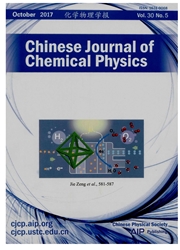

 中文摘要:
中文摘要:
利用高温分子动力学模拟和红外光谱实验手段,研究了一个基于分子力学力场的酰胺-Ⅰ带振动频率图的温度依赖性.结果表明,基于298K所建立的频率图可以应用,上至500K的分子动力学轨迹,所模拟的红外光谱能够很好地重复88℃时的实验光谱.另外还模拟了两个含有天然和非天然氨基酸残基的三肽分子的红外光谱,与实验结果相比得到了较好的符合.结果表明,所建立的频率图能够用于获得多肽体系在不同温度下的酰胺-Ⅰ带局域模振动频率及其分布,有助于深入认识多肽的热去折叠物种的红外光谱特征.
 英文摘要:
英文摘要:
In our recent work [Phys. Chem. Chem. Phys. 11, 9149 (2009)], a molecular-mechanics force field-based amidc-Ⅰ vibration frequency map (MM-map) for peptides and proteins was constructed. In this work, the temperature dependence of the MM-map is examined based on high-temperature molecular dynamics simulations and infrared (IR) experiments. It is shown that the 298-K map works for up to 500-K molecular dynamics trajectories, which reasonably reproduces the 88 ℃ experimental IR results. Linear IR spectra are also simulated for two tripeptides containing natural and unnatural amino acid residues, and the results are in reasonable agreement with experiment. The results suggest the MM-map can be used to obtain the temperature-dependent amide-Ⅰ local mode frequencies and their distributions for peptide oligomers, which is useful in particular for understanding the IR signatures of the thermally unfolded species.
 同期刊论文项目
同期刊论文项目
 同项目期刊论文
同项目期刊论文
 Anharmonic overtone and combination states of glycine and two model peptides examined by vibrational
Anharmonic overtone and combination states of glycine and two model peptides examined by vibrational Anharmonic vibrations of nucleobases:Structural basis of one-and two-dimensional infrared spectra fo
Anharmonic vibrations of nucleobases:Structural basis of one-and two-dimensional infrared spectra fo 期刊信息
期刊信息
